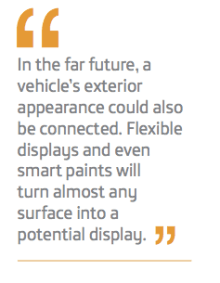By Ian Pearson(@timeguide), Futurist, Futurizon, BSc DSc (hc)
What do we envisage for the Connected Car over the next ten years? I see this space developing into a fully personalised, virtual environment with intelligent automation, creating a totally new relationship between the vehicle, the driver, and the passenger.
Cars used to be solitary machines. Not so anymore – some can now detect other vehicles around them and even “talk” to them. When cars are able to connect to each other in this way, things can get truly exciting – they can coordinate braking and acceleration, hence distancing themselves automatically with lightning-fast reaction times.
We could see a single stretch of road accommodating more cars safely, automatic management of lane changes, and even more efficient use of roundabouts.
In fact, fully self-driving cars will increase road capacity five-fold, eliminating congestion on most roads while reducing accidents to almost zero.
Connected Cars help make connected communities
Connecting cars also changes the way we make use of them. If safety and maintenance can be taken for granted, we as the passengers would be more willing to carpool and share them, for instance with systems like the already popular Zipcar. If you can find and rent a car easily, and find a parking space to leave it in when you are finished with it, the incentive for ownership can be greatly reduced.
This kind of car sharing will free up car parks, reduce congestion and make it easier, faster, and cheaper to travel.
Even today, car-sharing can already be improved using apps. As phones become even smarter, with location, payments, security and identification as standard tools, the pool of people that you know you can safely share a car with will increase, reducing social barriers to sharing while making logistics easier. This helps the environment by reducing traffic, but also builds bonds in the community.
Could every car feel like ‘your’ car?
Further in the future, cars will come to you. They will take you where you want, and then you can just abandon them to go off to serve someone else. They will in effect offer a comfortable and socially inclusive form of public transport. This could even lead to buses disappearing from our streets.
The personalisation of the car environment will also become common!
As you get in, the seat will automatically move to your preferred position, as instructed by your phone. Even fabrics and other interior surfaces will be able to adapt their appearance and textures electronically to your taste.
This could reduce the demand for ownership even further. Why own your own car when every car feels like it is yours?
Electric cars will receive a significant boost from the rise of the Connected Car – they could (in the far future) even be powered by inductive mats in the road surface, with super-capacitor banks instead of bulky batteries, solving both range and cost problems.
All cars will become virtual environments
Heads-up displays let drivers keep their eyes on the road. Many people will wear video visors that overlay data onto the field of view, making augmented reality a part of everyday life, and changing the appearance of everything around us, including car interiors and the world outside.
In-car sensors will recognise and highlight points of interest and dangers ahead. Passengers will see an electronically enhanced world too, with information overlaid into their view, in addition to games, video entertainment and web access. Some of this data will come from the car and some from apps on their phone.

Augmented reality will even allow some in-car equipment to be virtualised, allowing extra accessories to be bought and installed virtually.
Inter-car comms will let people interact with those nearby, but will also make other communications better. Cars could easily act as mobile cells, repeating and relaying mobile and wireless signals, to extend high speed communications throughout a whole line of cars.
This will make it a rare experience to be out of touch even in poor signal areas. Inter-car signals could use part of the mobile spectrum, wireless LANs, or even optical connections.
In the far future, a vehicle’s exterior appearance could also be connected. Flexible displays and even smart paints will turn almost any surface into a potential display. It’s easy to imagine lines of cars coordinating décor with the local environment, or even displaying garish videos and huge banner ads.
Although there are many routes to service provision that will keep the field highly competitive over the next decade, the key as always is quality. OEMs will provide high quality platforms that link fully, and with full synergy, into the car, so will be in pole position to utilise them.
Being in control of the operating systems, comms and computing platforms will be a huge advantage and allow a seamless interfacing with additional special features only available to their customer. In many ways, the battles will be similar to those between features built into smartphones versus downloadable apps, but in the car of course there are more opportunities to link to exclusively accessible hardware and sensors.
This will continue to provide abundant OEM opportunities, but with no room for complacency, since even small weaknesses will readily be exploited by outside companies.
![[Guest Post] The Connected Car will be fully personalised in 10 years, predicts futurist](https://en.blogthinkbig.com/wp-content/uploads/sites/5/2014/04/shutterstock_131473766-cars.jpg?resize=610%2C225)

![[Interviews] Nissan and Cadillac on the new model for the Connected Car industry](https://en.blogthinkbig.com/wp-content/uploads/sites/5/2014/07/carousel-conn-cars-CC.jpg?resize=p%2Co)
![[Blog] Collaboration will power the Connected Car industry](https://en.blogthinkbig.com/wp-content/uploads/sites/5/2013/08/carousel-new-bmw.jpg?resize=p%2Co)





